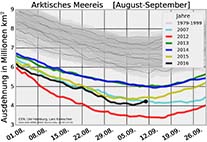Open waters around the North Pole: Arctic sea ice in retreat
13 September 2016, by CEN Universität Hamburg

Photo: UHH/CEN/Kaleschke
This September, the Arctic sea ice extent has shrunk to 4.1 million square kilometres (sq km)—the second lowest in the history of satellite
This September, the Arctic sea ice extent has shrunk to 4.1 million square kilometres (sq km)—the second lowest in the history of satellite measurements. It is exceeded only by the all-time record low of 3.4 million sq km in 2012. “Once again, a massive loss of sea ice in the Arctic,” says Prof. Lars Kaleschke from Universität Hamburg’s Center for Earth System Research and Sustainability (CEN). His colleague Prof. Christian Haas from the Alfred Wegener Institute (AWI) confirms: “The trend continues.” Currently, the Northeast and Northwest Passages are navigable at the same time.
September is the time for annual stocktaking. As the Arctic melt season nears its end, the remaining ice cover called September minimum is an important climate change indicator. “In the winter 2015/16, air temperatures over large parts of the Arctic Ocean ranged more than 6 °Celsius above the long-term average,” explains CEN sea ice physicist Kaleschke. “Higher temperatures stunt winter sea ice growth.”
The ice thickness was examined as well. High resolution measurements via aircraft in various Arctic regions reveal: “Especially the newly formed first-year ice was very thin this year, hardly more than one meter. Normally, it is almost twice as thick,” explains Christian Haas. “The multiyear ice, by contrast, was about as thick as in previous years, about 3 to 4 meters. This delayed the June and July ice losses considerably before strong winds kicked off the melt in August after all.” Aiming for continuous ice thickness measurements, Universität Hamburg and the AWI jointly developed a new data product. A first in combining measurements of the two ESA satellites CryoSat and SMOS it can indicate trends. “Thus, by the end of the Arctic winter, we could already see that the ice was 10 centimeters thinner than in previous years—a significant decline” according to Lars Kaleschke.
The current sea ice extent is determined based on satellite data. A procedure enhanced by Kaleschke’s team allows for exact imagery resolutions up to 3 kilometers. Hitherto, exact resolutions ran at not less than 12 kilometres. The innovative visualization yields particularly clear images of details, such as vortices, channels, and ice edges, providing valuable clues about ice dynamics and thus its stability. Hence, we can see the unusually early breakup of sea ice in April north of Alaska, the so-called Beaufort Sea vortex. Compared with past years, the May and June ice extents were indeed much lower than ever before. Also extraordinary: even the central sea ice in the immediate vicinity of the North Pole is showing numerous open water areas this year.
The Northeast and Northwest Passages have been ice-free again since the end of August 2016. For the past few weeks, Yachts and a cruise ship have been using the southern route of the Northwest Passage. In 2008, both passages had been passable simultaneously for the first time.
Arctic sea ice is considered a tipping element in the climate system and an early warning system for global warming. In the 1970s and 80s, summer minimums still averaged around 7 million sq km. “The retreating Arctic sea ice clearly indicates unmitigated global warming,” says Lars Kaleschke.
More information here
Sea ice thickness up until February 2016 (a combination of CryoSAT and SMOS data)
Contacts
Prof. Lars Kaleschke
CEN—Centrum für Erdsystemforschung und Nachhaltigkeit
Bundesstraße 53, 20146 Hamburg
lars.kaleschke"AT"uni-hamburg.de
Tel: +49 40 42838-6518
Prof. Christian Haas
Alfred-Wegener-Institut, Helmholtz-Zentrum für Polar- und Meeresforschung
Bussestraße 24, 27570 Bremerhaven
christian.haas"AT"awi.de
Tel: +49 40 471 4831-2285
Stephanie Janssen
Outreach
CEN–Centrum für Erdsystemforschung und Nachhaltigkeit
Grindelberg 5, 20144 Hamburg
stephanie.janssen"AT"uni-hamburg.de
Tel: +49 40 42838-7596
Sina Löschke
Pressereferentin, Kommunikation und Medien
Alfred-Wegener-Institut, Helmholtz-Zentrum für Polar- und Meeresforschung
Tel: +49 40 471 4831-2008
sina.loeschke"AT"awi.de
